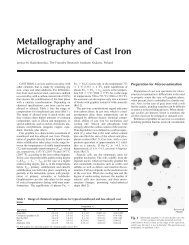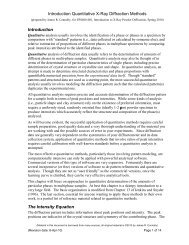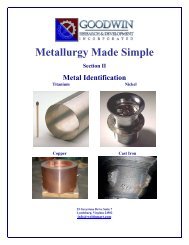ITP Metal Casting: 2002 Metal Casting Industry of the Future ...
ITP Metal Casting: 2002 Metal Casting Industry of the Future ...
ITP Metal Casting: 2002 Metal Casting Industry of the Future ...
Create successful ePaper yourself
Turn your PDF publications into a flip-book with our unique Google optimized e-Paper software.
• Yield Improvement and Defect Reduction in Steel <strong>Casting</strong> - Advancing technology in yield<br />
improvement and defect reduction will result in decreased scrap and rework, along with an increase<br />
in yield and higher quality steel castings produced with less iteration. Researchers at <strong>the</strong> University<br />
<strong>of</strong> Iowa have developed new feeding distance rules for risering and pressurization <strong>of</strong> risers that will<br />
reduce shrinkage and increase yield in steel castings. This research program has also assisted in<br />
<strong>the</strong> development <strong>of</strong> solidification models to quantify solidification shrinkage. The ASTM E07.02<br />
Committee has accepted <strong>the</strong> need for a new set <strong>of</strong> radiographic standards for steel castings, and<br />
this research program is forming <strong>the</strong> basis for those standards. The results <strong>of</strong> this research are<br />
expected to improve yield by 10-25% with an equal reduction in melt energy requirements. To learn<br />
more, please visit http://www.oit.doe.gov/metalcast/factsheets/ui_yield_def.pdf.<br />
• Development <strong>of</strong> a Computational Fluid Dynamics Tool for Modeling <strong>the</strong> Blowing and<br />
Steaming <strong>of</strong> Expandable Polystyrene (EPS) Patterns for Lost Foam <strong>Casting</strong> -<br />
Researchers at Flow Simulation Services, Inc. have developed a ma<strong>the</strong>matical tool that will allow,<br />
for <strong>the</strong> first time, an analytical approach to systematically design EPS pattern molds that will produce<br />
higher quality patterns with reduced lead-time and expense.<br />
These math-based tools solve equations that model physical<br />
phenomena important to <strong>the</strong> pattern production process. Both a<br />
bead blowing and bead expansion module was created. The bead<br />
blowing module became available in December 2001. A second<br />
version <strong>of</strong> <strong>the</strong> module was released in October <strong>2002</strong>, for purchase<br />
by foundry engineers. In December <strong>of</strong> <strong>2002</strong> <strong>the</strong> first release <strong>of</strong><br />
<strong>the</strong> bead expansion module became available. These s<strong>of</strong>tware<br />
packages are being used by a major automobile manufacturer to Box Pattern Filling<br />
address manufacturing design issues as well as to solve bottlenecks. This research is expected to<br />
achieve significant defect reductions resulting in yield improvements <strong>of</strong> about 10% with an equal<br />
reduction in melting requirements. To learn more, please visit http://www.arena-flow.com.<br />
• Non-Incineration Treatment to Reduce Benzene and VOC Emissions for Green Sand<br />
Molding System - Green sand foundries are under increasing pressure to reduce benzene and<br />
volatile organic carbon (VOC) emissions during pouring, cooling, and shakeout. Conventional<br />
incineration systems to treat stack gas are costly to operate and difficult to<br />
maintain. Researchers at Pennsylvania State University have been<br />
researching methods to develop a cost effective non-incineration technique<br />
that will significantly reduce VOC emissions from foundries. They have<br />
been conducting Advanced Oxidants (AO) emissions and sand<br />
performance trials at <strong>the</strong> university and at five participating foundries. All<br />
five <strong>of</strong> <strong>the</strong>se foundries have adopted or are in <strong>the</strong> process <strong>of</strong> adopting <strong>the</strong><br />
AO system. The research has shown that Benzene and VOC emissions<br />
can be reduced by 10-75%; sand system premix consumption can be<br />
reduced by 15-42%; foundry smoke is reduced; and AO Technology is<br />
scalable for small, medium, and large foundries. For more information,<br />
please visit http://www.oit.doe.gov/metalcast/factsheets/voc_psu.pdf.<br />
Advanced oxidation<br />
processing has reduced<br />
smoke, odor and emissions<br />
in foundries.<br />
• Investigation <strong>of</strong> Heat Transfer at <strong>the</strong> Mold-<strong>Metal</strong> Interface in Permanent Mold-<br />
<strong>Casting</strong> <strong>of</strong> Light Alloys - Researchers at <strong>the</strong> University <strong>of</strong> Michigan have focused <strong>the</strong>ir work on<br />
improving <strong>the</strong> design functions supporting production <strong>of</strong> light alloy castings produced by permanent<br />
mold casting processes. This work provides <strong>the</strong> basis for <strong>the</strong> production <strong>of</strong> castings having thinner<br />
walls, lighter weight, higher integrity, and improved mechanical properties. Their research has<br />
developed and experimentally verified a new approach to estimating interfacial heat transfer in<br />
Indirect Squeeze <strong>Casting</strong> and Low Pressure Permanent Mold <strong>Casting</strong>. This new method takes into<br />
account variations within <strong>the</strong> mold as well as time dependent variations <strong>of</strong> interfacial heat transfer. It<br />
provides a range <strong>of</strong> heat transfer parameters that will aid <strong>the</strong> optimization <strong>of</strong> <strong>the</strong> design <strong>of</strong> <strong>the</strong> mold<br />
to meet <strong>the</strong> quality and productivity goals with a short lead-time. Fur<strong>the</strong>r work in this research will<br />
extend <strong>the</strong> rules for heat transfer in simple geometries to more complex geometries. Accurate<br />
22








